Fragment Android是在Android 3.0 (API level 11)開始引入Fragment的。
可以把Fragment想成Activity中的模塊,這個模塊有自己的布局,有自己的生命周期,單獨處理自己的輸入,在Activity運行的時候可以加載或者移除Fragment模塊。
可以把Fragment設計成可以在多個Activity中復用的模塊。
當開發的應用程序同時適用於平板電腦和手機時,可以利用Fragment實現靈活的布局,改善用戶體驗。
如圖:
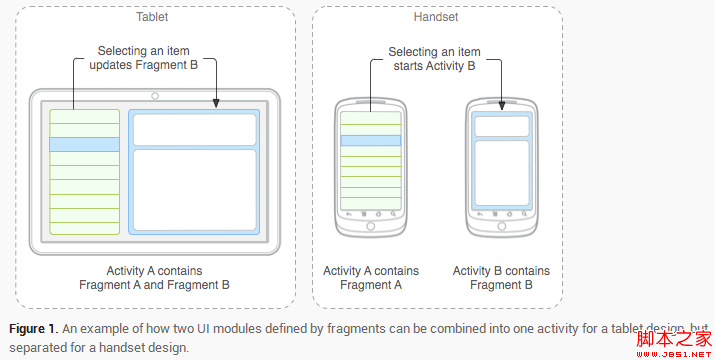 Fragment的生命周期
Fragment的生命周期 因為Fragment必須嵌入在Acitivity中使用,所以Fragment的生命周期和它所在的Activity是密切相關的。
如果Activity是暫停狀態,其中所有的Fragment都是暫停狀態;如果Activity是stopped狀態,這個Activity中所有的Fragment都不能被啟動;如果Activity被銷毀,那麼它其中的所有Fragment都會被銷毀。
但是,當Activity在活動狀態,可以獨立控制Fragment的狀態,比如加上或者移除Fragment。
當這樣進行fragment transaction(轉換)的時候,可以把fragment放入Activity的back stack中,這樣用戶就可以進行返回操作。
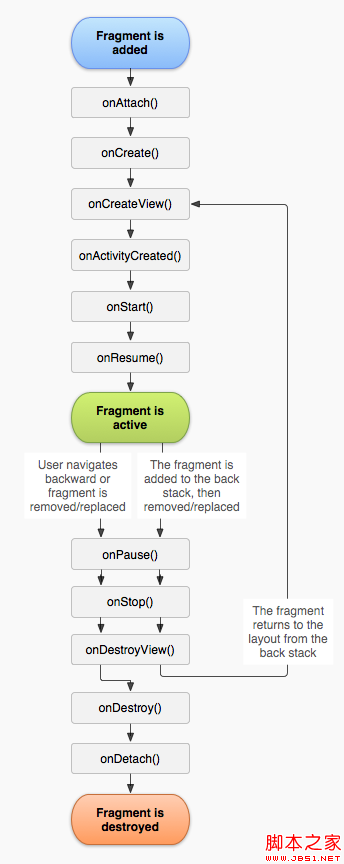 Fragment的使用相關
Fragment的使用相關 使用Fragment時,需要繼承Fragment或者Fragment的子類(DialogFragment, ListFragment, PreferenceFragment, WebViewFragment),所以Fragment的代碼看起來和Activity的類似。
使用Support Library
Support Library是一個提供了API庫函數的JAR文件,這樣就可以在舊版本的Android上使用一些新版本的APIs。
比如android-support-v4.jar.它的完整路徑是:
<sdk>/extras/android/support/v4/android-support-v4.jar.
它就提供了Fragment的APIs,使得在Android 1.6 (API level 4)以上的系統都可以使用Fragment。
為了確定沒有在舊版本系統上使用新版本的APIs,需要如下導入語句:
復制代碼 代碼如下:
import android.support.v4.app.Fragment;
import android.support.v4.app.FragmentManager;
同時應該將上述的包拷入libs項目下的libs文件夾,然後在項目的Properties中添加:右鍵單擊項目,選Properties,左邊選Java Build Path,然後Add External JARs…,添加android-support-v4.jar.
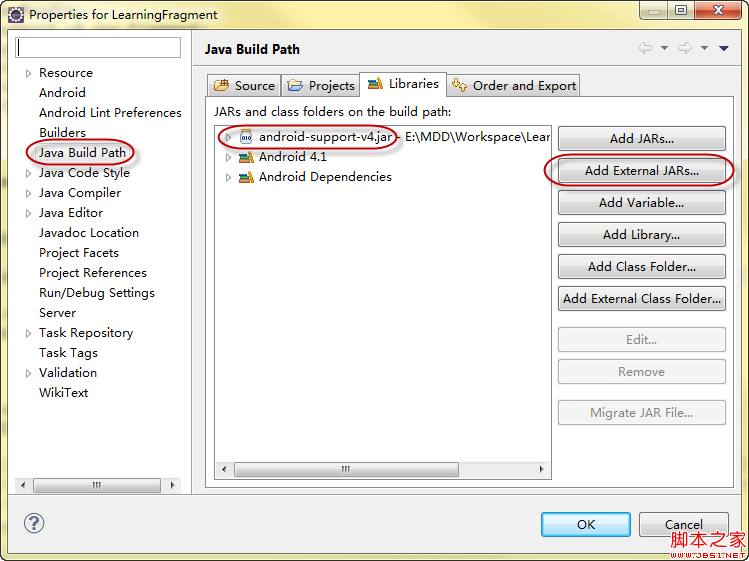
當創建包含Fragment的Activity時,如果用的是Support Library,那麼繼承的就應該是FragmentActivity而不是Activity。
必須實現的三個回調函數
onCreate()
系統在創建Fragment的時候調用這個方法,這裡應該初始化相關的組件,一些即便是被暫停或者被停止時依然需要保留的東西。
onCreateView()
當第一次繪制Fragment的UI時系統調用這個方法,必須返回一個View,如果Fragment不提供UI也可以返回null。
注意,如果繼承自ListFragment,onCreateView()默認的實現會返回一個ListView,所以不用自己實現。
onPause()
當用戶離開Fragment時第一個調用這個方法,需要提交一些變化,因為用戶很可能不再返回來。
實現Fragment的UI 提供Fragment的UI,必須實現onCreateView()方法。
假設Fragment的布局設置寫在example_fragment.xml資源文件中,那麼onCreateView()方法可以如下寫:
復制代碼 代碼如下:
public static class ExampleFragment extends Fragment
{
@Override
public View onCreateView(LayoutInflater inflater, ViewGroup container,
Bundle savedInstanceState)
{
// Inflate the layout for this fragment
return inflater.inflate(R.layout.example_fragment, container, false);
}
}
onCreateView()中container參數代表該Fragment在Activity中的父控件;savedInstanceState提供了上一個實例的數據。
inflate()方法的三個參數:
第一個是resource ID,指明了當前的Fragment對應的資源文件;
第二個參數是父容器控件;
第三個布爾值參數表明是否連接該布局和其父容器控件,在這裡的情況設置為false,因為系統已經插入了這個布局到父控件,設置為true將會產生多余的一個View Group。
把Fragment加入Activity 當Fragment被加入Activity中時,它會處在對應的View Group中。
Fragment有兩種加載方式:一種是在Activity的layout中使用標簽<fragment>聲明;另一種方法是在代碼中把它加入到一個指定的ViewGroup中。
另外,Fragment它可以並不是Activity布局中的任何一部分,它可以是一個不可見的部分。這部分內容先略過。
加載方式1:通過Activity的布局文件將Fragment加入Activity 在Activity的布局文件中,將Fragment作為一個子標簽加入即可。
如:
復制代碼 代碼如下:
<?xml version="1.0" encoding="utf-8"?>
<LinearLayout xmlns:android="http://schemas.android.com/apk/res/android"
android:orientation="horizontal"
android:layout_width="match_parent"
android:layout_height="match_parent">
<fragment android:name="com.example.news.ArticleListFragment"
android:id="@+id/list"
android:layout_weight="1"
android:layout_width="0dp"
android:layout_height="match_parent" />
<fragment android:name="com.example.news.ArticleReaderFragment"
android:id="@+id/viewer"
android:layout_weight="2"
android:layout_width="0dp"
android:layout_height="match_parent" />
</LinearLayout>
其中android:name屬性填上你自己創建的fragment的完整類名。
當系統創建這個Activity的布局文件時,系統會實例化每一個fragment,並且調用它們的onCreateView()方法,來獲得相應fragment的布局,並將返回值插入fragment標簽所在的地方。
有三種方法為Fragment提供ID:
android:id屬性:唯一的id
android:tag屬性:唯一的字符串
如果上面兩個都沒提供,系統使用容器view的ID。
加載方式2:通過編程的方式將Fragment加入到一個ViewGroup中 當Activity處於Running狀態下的時候,可以在Activity的布局中動態地加入Fragment,只需要指定加入這個Fragment的父View Group即可。
首先,需要一個FragmentTransaction實例:
FragmentManager fragmentManager = getFragmentManager()
FragmentTransaction fragmentTransaction = fragmentManager.beginTransaction();(注,如果import android.support.v4.app.FragmentManager;那麼使用的是:FragmentManager fragmentManager = getSupportFragmentManager();)
之後,用add()方法加上Fragment的對象:
ExampleFragment fragment = new ExampleFragment();
fragmentTransaction.add(R.id.fragment_container, fragment);
fragmentTransaction.commit();
其中第一個參數是這個fragment的容器,即父控件組。
最後需要調用commit()方法使得FragmentTransaction實例的改變生效。
實例
練習的例子:
寫一個類繼承自Fragment類,並且寫好其布局文件(本例中是兩個TextView),在Fragment類的onCreateView()方法中加入該布局。
之後用兩種方法在Activity中加入這個fragment:
第一種是在Activity的布局文件中加入<fragment>標簽;
第二種是在Activity的代碼中使用FragmentTransaction的add()方法加入fragment。
貼出代碼:
自己定義的fragment類:
復制代碼 代碼如下:
ExampleFragment.java
package com.example.learningfragment;
import android.os.Bundle;
import android.support.v4.app.Fragment;
import android.view.LayoutInflater;
import android.view.View;
import android.view.ViewGroup;
public class ExampleFragment extends Fragment
{
//三個一般必須重載的方法
@Override
public void onCreate(Bundle savedInstanceState)
{
// TODO Auto-generated method stub
super.onCreate(savedInstanceState);
System.out.println("ExampleFragment--onCreate");
}
@Override
public View onCreateView(LayoutInflater inflater, ViewGroup container,
Bundle savedInstanceState)
{
System.out.println("ExampleFragment--onCreateView");
return inflater.inflate(R.layout.example_fragment_layout, container, false);
}
@Override
public void onPause()
{
// TODO Auto-generated method stub
super.onPause();
System.out.println("ExampleFragment--onPause");
}
@Override
public void onResume()
{
// TODO Auto-generated method stub
super.onResume();
System.out.println("ExampleFragment--onResume");
}
@Override
public void onStop()
{
// TODO Auto-generated method stub
super.onStop();
System.out.println("ExampleFragment--onStop");
}
}
fragment的布局文件:
復制代碼 代碼如下:
example_fragment_layout.xml
<?xml version="1.0" encoding="utf-8"?>
<LinearLayout xmlns:android="http://schemas.android.com/apk/res/android"
android:layout_width="match_parent"
android:layout_height="match_parent"
android:orientation="vertical" >
<TextView
android:layout_width="match_parent"
android:layout_height="wrap_content"
android:text="@string/num1"
/>
<TextView
android:layout_width="match_parent"
android:layout_height="wrap_content"
android:text="@string/num2"
/>
</LinearLayout>
主Activity:
復制代碼 代碼如下:
LearnFragment.java
package com.example.learningfragment;
import android.os.Bundle;
import android.support.v4.app.FragmentActivity;
import android.support.v4.app.FragmentManager;
import android.support.v4.app.FragmentTransaction;
public class LearnFragment extends FragmentActivity
{
@Override
public void onCreate(Bundle savedInstanceState)
{
super.onCreate(savedInstanceState);
setContentView(R.layout.activity_learn_fragment);
//在程序中加入Fragment
FragmentManager fragmentManager = getSupportFragmentManager();
FragmentTransaction fragmentTransaction = fragmentManager.beginTransaction();
ExampleFragment fragment = new ExampleFragment();
fragmentTransaction.add(R.id.linear, fragment);
fragmentTransaction.commit();
}
}
Activity的布局文件:
復制代碼 代碼如下:
activity_learn_fragment.xml
<LinearLayout xmlns:android="http://schemas.android.com/apk/res/android"
xmlns:tools="http://schemas.android.com/tools"
android:layout_width="match_parent"
android:layout_height="match_parent"
android:orientation="vertical"
>
<Button
android:id="@+id/btn1"
android:layout_width="fill_parent"
android:layout_height="wrap_content"
android:text="@string/btn1"
/>
<fragment
android:name="com.example.learningfragment.ExampleFragment"
android:id="@+id/fragment1"
android:layout_width="match_parent"
android:layout_height="wrap_content"
/>
<Button
android:id="@+id/btn2"
android:layout_width="fill_parent"
android:layout_height="wrap_content"
android:text="@string/btn2"
/>
<LinearLayout
xmlns:android="http://schemas.android.com/apk/res/android"
android:id="@+id/linear"
android:layout_width="fill_parent"
android:layout_height="wrap_content"
android:orientation="vertical"
>
<Button
android:id="@+id/btn3"
android:layout_width="fill_parent"
android:layout_height="wrap_content"
android:text="@string/btn3"
/>
</LinearLayout>
</LinearLayout>
運行結果如下:
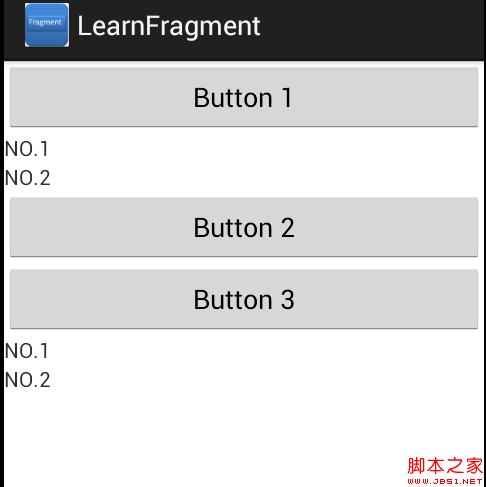
可以看到第二種方式加入fragment的時候,指定了父容器(一個線性布局)的id,其中已經有一個Button 3,所以fragment加在其後。
參考資源
Fragment類文檔:
http://developer.android.com/reference/android/app/Fragment.html
Training:Building a Dynamic UI with Fragments
http://developer.android.com/training/basics/fragments/index.html
Fragments Develop Guide:
http://developer.android.com/guide/components/fragments.html



 可以看到第二種方式加入fragment的時候,指定了父容器(一個線性布局)的id,其中已經有一個Button 3,所以fragment加在其後。
可以看到第二種方式加入fragment的時候,指定了父容器(一個線性布局)的id,其中已經有一個Button 3,所以fragment加在其後。 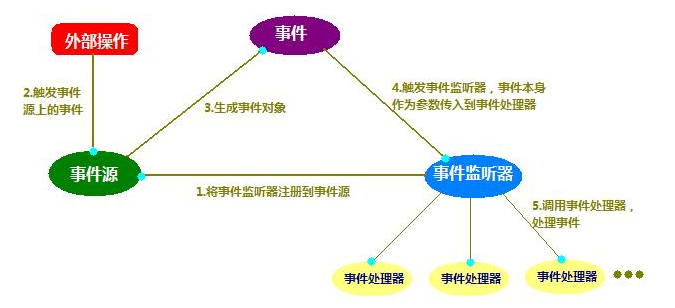 Android廣播接實現監聽電話狀態(電話的狀態,攔截)
Android廣播接實現監聽電話狀態(電話的狀態,攔截)
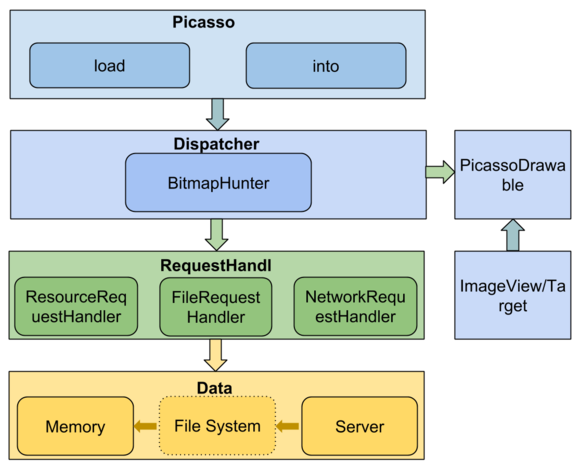 Picasso源碼分析
Picasso源碼分析
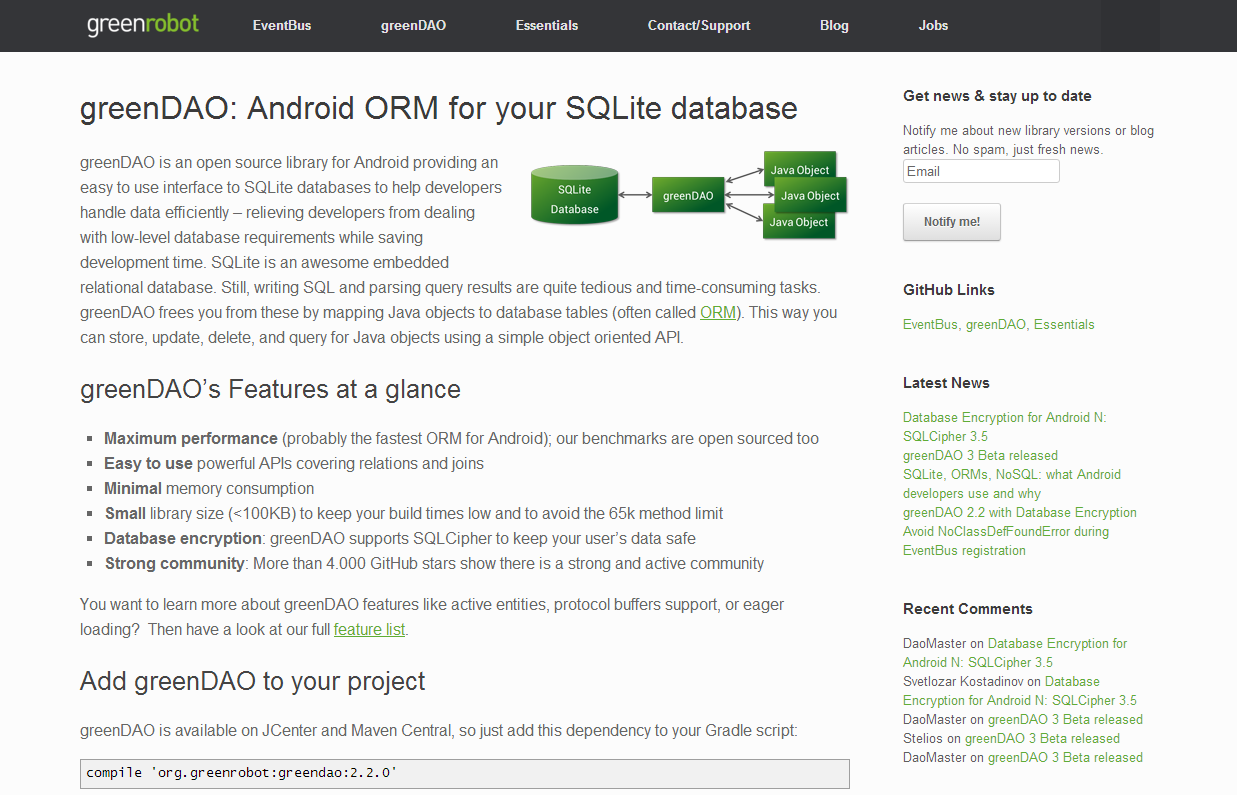 Android數據庫框架——GreenDao輕量級的對象關系映射框架
Android數據庫框架——GreenDao輕量級的對象關系映射框架
 Android之內容提供器Content Provider詳解(一)
Android之內容提供器Content Provider詳解(一)